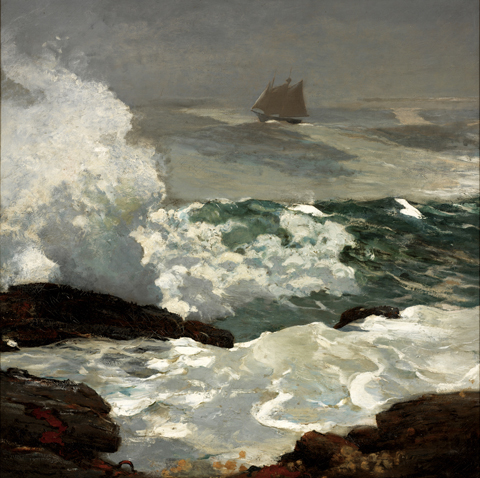
NOSTALGIA FOR POWER Homer's 'On a Lee Shore.' |
The question of what the United States means snakes through “Making It In America” at the RISD Museum (224 Benefit St, Providence, through February 9). The answer begins with people like George Washington in Gilbert Stuart’s circa 1820 portrait. It’s one of the Rhode Island native’s many copies of his famous 1796 dollar bill portrait of the first president — done two decades after the original, and after Washington’s death.
Washington is the humble hero non-king, his craggy face chiseled out of Mount Rushmore. In these early American portraits, people become icons of the Revolutionary generation’s ideals — liberty, democracy, equality, clarity, unpretentious, clean-scrubbed faces.
This attitude is also evident in the late 18th-century furniture that curators Maureen O’Brien and Elizabeth Williams include in this survey of more than 100 American paintings, sculptures, chairs, and vases from the 1700s and 1800s from the museum’s collection. A Windsor armchair from around 1780 to 1800 is plain-spoken in its design of rounded seat and airy curved back rail and spindles. The art resides in its flinty, elegant, unornamented spareness.
But soon the iconography changes. Maybe a turning point is already in 11-year-old Nabby Martin’s 1786 sampler of elegant folks cavorting among flowers and deer near an early Rhode Island statehouse and Brown University hall under the stitched motto “Let virtue be a guide to thee.”
Instead of we the people, the subject becomes the sweet land of liberty, especially the Wild West beginning with western New York in Thomas Cole’s 1847 Genesee Scenery (Mountain Landscape with Waterfall). A man walks a dirt path toward a log cabin next to a field cleared of trees. A woman and man chat on a bridge over a rushing waterfall and what might be a mill powered by the river. A hunter perches with his rifle on a bluff overlooking the gorge. It’s about opening up, taming, and exploiting the wilderness — including Native Americans. (RISD’s collection, like most American museums, is thin on works by women and folks of color, as well as depictions of non-whites.)
Then repeat across continent via Manifest Destiny and all that. Martin Johnson Heade’s 1864 painting depicts a hunter in the lush, humid Brazilian forest; William Bradford’s 1874 painting shows a sailing ship locked in a field of arctic ice and a sunset turning the snowy peaks Martian red.
People are fewer and farther between. In these landscapes, you sense a shift in American aims from equal people to owning stuff. It corresponds to the end of the Civil War, when the US government turned its attention toward corralling the last loose Native Americans and more of the western land became occupied by white settlers.
A nostalgia for the power of unconquered, unspoiled nature comes into works like On a Lee Shore, Winslow Homer’s 1900 painting of a gray ship in the distance being driven by the wind toward rocks. The spinning wheel that once had been an essential of American homemaking is recycled into a circa 1886 frontier-style chair attributed to William Savage with a wheel back.